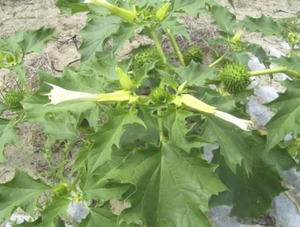We need you! Join our contributor community and become a WikEM editor through our open and transparent promotion process.
Jimson weed
From WikEM
Contents
Background
- Contains up to 28 different anticholinergic alkaloids[1]
- Atropine, hyoscyamine, and scopolamine
- All parts of the plant are toxic but the highest concentration is in the seeds
- 50-100 seeds in each pod
- 100 seeds is the equivalent of about 6mg atropine
- Estimated lethal doses of atropine in adults ≥10mg[2]
Administration
- Inhalation (smoking dried leaves or other plant parts)
- Ingestion (eating plant parts or foods containing extracts)
Clinical Features
- History of plant ingestion/smoking
- Anticholinergic toxidrome
- Symptoms can last for days if seeds were ingested
Differential Diagnosis
- Sympathomimetic toxicity
- Red, dry skin and absent bowel sounds favors anticholinergic toxicity
- Encephalitis
- Head trauma
- ETOH/sedative withdrawal
- Neuroleptic Malignant Syndrome (NMS)
- Acute psychotic disorder
Anticholinergic toxicity
- Medications
- Atropine
- Antihistamines
- Antidepressants
- Antipsychotics
- Muscle relaxants
- Anti-Parkinsonians
- Plants
- Jimson weed (Devil's trumpet)
- Amanita mushroom
Evaluation
Clinical diagnosis with history and physical exam
- Dry as a bone: anhidrosis (esp axillae, mouth)
- Hot as a hare: anhydrotic hyperthermia (may become severe w/ agitation)
- Red as a beet: cutaneous vasodilation
- Blind as a bat: nonreactive mydriasis (often delayed 12-24hr)
- Mad as a hatter: delirium; attention deficit; hallucinations; dysarthria; lethargy
- Full as a flask: urinary retention
- Tachycardia (HR 120-160) and decreased/absent bowel sounds
Management
- Supportive care and patient reassurance
- Sedation as needed with benzos
- In severe cases, physostigmine 0.5–2.0mg IV at a rate of no more than 1mg/min (adult dosing)
- A second dose may be administered if necessary
- Children should receive 0.02mg/kg intravenously and the rate should not exceed 0.5mg/min
See Also
References
- ↑ Krenzelok EP. Aspects of Datura poisoning and treatment. Clin Tox. 2010; 48(2):104-110.
- ↑ Shervette RE, et al. Jimson "loco" weed abuse in adolescents. Pediatrics. 1979; 63:520-523.
Authors
Neil Young, Colin Hoff, Ross Donaldson, Claire, Daniel Ostermayer

